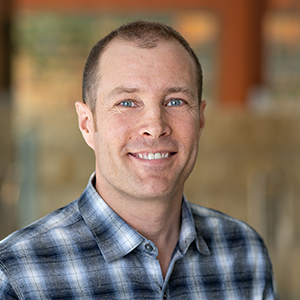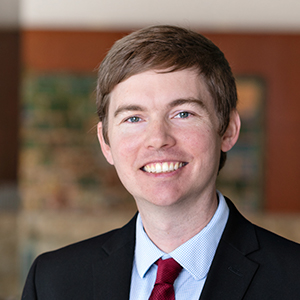Ryan Nunn Assistant Vice President, Community Development and Engagement
Economic research is embedded across the Minneapolis Fed. There is the Research Division, of course, focused on macroeconomics and often-theoretical work that informs monetary policy decisions. Economists of the Opportunity & Inclusive Growth Institute dive deep on the issues evident in the Institute’s name. Regional outreach economists track the vital statistics of the Ninth District economy, while economists in bank supervision train their gaze on financial stability.
Community Development and Engagement (CDE) fills another critical research space where economic theories meet on-the-ground data, public policy, and the lives of working people. Through research on housing, labor, credit, and more, CDE advances the economic well-being and prosperity of low- to moderate-income individuals, households, and communities, including a dedicated focus on Native communities through the Center for Indian Country Development.
Amid an endless menu of potential topics, state and local labor market practices have emerged as a major emphasis for CDE under the economist who leads its research efforts, Assistant Vice President Ryan Nunn. Nunn joined the Minneapolis Fed in 2020 after stints at the Brookings Institution and the U.S. Treasury’s Office of Economic Policy, where he co-authored reports that foreshadowed two CDE priorities: non-compete contracts and occupational licensing. We talked with Nunn about the how the multidisciplinary CDE team approaches its broader research agenda, and especially “a labor market that works for all.”
We spoke on March 15, 2023.
What is the thread that ties together the different elements of CDE’s research on labor markets?
This is all about access to economic opportunity. The idealized, competitive-labor-market model from economics textbooks is more aspiration than reality. I see us working to identify opportunities where labor markets can be made more competitive—and where the benefits of doing that are accrued both by workers and by the overall economy.
For example, if occupational licensing is throwing up barriers—and especially so for certain groups—then we are not seeing people matched with the best jobs for their talents. If non-compete agreements are making it inordinately difficult for workers to switch jobs or to negotiate better terms of employment, that is a departure from the competitive model of how labor markets should work. The same goes for trying to make reemployment services more robust, which makes labor markets more flexible and fluid.
Thinking about how our labor market policies can support productivity and greater employment is a direct extension of the Fed’s “maximum employment” mandate.
Much of your research has highlighted trends that affect low- and moderate-income workers and marginalized groups. Do you see CDE’s research as fundamentally about economic inequality?
There are other researchers doing great work to document and understand inequality, per se. We are more trying to focus on key labor market policies that are an underappreciated, understudied part of determining the access that workers have to opportunity and who gets that access. Once we understand how these policies are affecting workers, we can identify opportunities to improve them—especially how they could be tweaked to better support lower- and moderate-income workers.
It’s important to underscore that the goal of boosting wages for lower-wage workers and the goal of having a more dynamic and productive economy are not in opposition—in fact, they are often nicely aligned. By lowering the barriers to work, we can help workers to get what they would like out of their labor market experiences. But we can also have a labor market that better matches workers to the jobs that fit their talents—a labor market that maximizes productivity. That’s something that’s broadly valuable to all of us.
How does the economic research that happens in CDE differ from other economic research that happens at the Minneapolis Fed and in the Federal Reserve System?
One comparative advantage of ours is finding analytical questions that really aren’t getting the attention that they should from academic researchers. In some cases, that’s because the data are not there to answer the causal questions. But our team can focus first on just understanding the lay of the land—getting a descriptive analysis of a policy or some meaningful aspect of housing or labor markets that would be helpful for decision-makers.
Another comparative advantage is our relationships with stakeholders in our district, which help us generate opportunities to access new data. To the extent that some of these data are held by state governments, for example, being able to work with them to understand their data, and to answer questions about it, is something we are in a good place to do.
It also seems to me that your team can be relatively nimble because your goals and your audience are a little bit different than other hubs of research at the Bank.
That’s right. Because we are not exclusively interested in trying to publish articles in academic journals, it frees us up to focus on other types of questions that often can be answered more quickly. There are cases when we can provide rigorous analysis in a timely way for decision-makers as they figure out how to support workers in the labor market and elsewhere in their economic lives.
You do work on some timely topics, which we’ll get into in a moment. What’s the context in which CDE engages with stakeholders?
We’re not in the business of trying to advocate for policies or get into the weeds of policy design. We engage with decision-makers and other stakeholders in a purely informational capacity, to provide rigorous analysis of policy-relevant questions. I think that that’s often incredibly valuable because community leaders are frequently in a position of having to make calls with very little information.
If you’re a state or local official making rules about some of these labor market policies like licensing and non-competes, ideally you will be aware of the range of research findings relevant to those policies. Some of these findings we’ve developed in our group, and many of them we can bring in from the broader research community.
You have a multidisciplinary team bringing their talents to the task—not everybody is an economist.
All of them are necessary to formulating a sensible research agenda and then making sure that the findings are of value to people that we aim to serve. The economists are in a good position to think deeply about the economic logic of a given situation and where it is possible to identify causal impacts of policies. Our data scientists are incredibly skilled at structuring and exploring our data, as well as making it available to broader audiences with compelling data tools. And our colleagues on the policy and engagement teams are essential for making sure that the research questions that we’re picking are good and relevant ones, that we’re addressing them in ways that accurately reflect the institutional environment, and that we have opportunities to bring our research findings to the folks who can use them.
Establishing the “lay of the land” on non-competes
The prevalence and economic impact of non-compete contracts have been a major recent focus. What would you offer as one major takeaway from that work to date that should inform the policy conversation?
One incredibly basic takeaway that I think is still not fully appreciated is that a substantial fraction of low- and middle-wage workers actually have non-competes (Figure 1). Understanding that non-competes are so broadly distributed changes the nature of the policy discussion, because it’s no longer just a question of folks who have access to a lot of legal representation and can undertake true negotiations—executives or highly paid tech workers. It’s now also a matter for people who go into their first job, are handed a stack of paperwork to sign as they as they enter, and are confronted with something like a non-compete contract when they may have little information about what it means for them and limited ability to negotiate.
Where is the non-competes research going next?
A lot of the recent work has been establishing that lay of the land: Who has these non-competes and do they respond to them? But there aren’t many surveys that have asked about non-competes. This year, for the first time, the Fed’s own Survey of Household Economics and Decisionmaking (SHED) will include questions about non-competes. Because the SHED asks households a lot of interesting questions, we will have an opportunity to examine things like how financially precarious people are who have non-competes, and a whole host of other questions that will be possible because the SHED is this great, fairly large survey.
Another answer to your question would be that the research community is looking at how non-competes are bundled with other types of restrictive covenants in the labor markets—things like non-disclosure agreements, non-solicitation agreements, intellectual property assignment rules. These are often bundled together, and it will be a challenge for researchers to disentangle the effects that each type of covenant has.
Understanding the trade-offs of occupational licensing
Occupational licensing has been another big research priority. States in the Ninth District require licenses for all kinds of jobs: manicurists, landscape architects, auctioneers. What has been a meaningful insight on that front that you would want to highlight?
I’m continually struck by the public discussion about licensing that often treats it as a binary—an on/off switch where licensing either exists or it doesn’t in an occupation in the state—and that’s the only choice in front of us. And the discussion will sometimes focus on occupations where the case for licensure is particularly weak.
I think that that’s an entirely reasonable discussion to have, but I am really interested in a different discussion about how we license occupations that most of us agree should be licensed. The justification for licensure is protecting public health and safety. Most of us agree that in key health care occupations, for example, licensure has a role. All of the states license physicians, all of them license nurse practitioners. But there are questions about what nurse practitioners are permitted to do under the terms of their licensure. And while this may sound really wonky, it actually matters quite a bit: It matters to the workers and their ability to practice to the full extent of their training. It matters for the wages of the medical practitioners. It matters to outcomes for patients. It matters for the wider economy.
Making the labor market more competitive and more dynamic can often be achieved by tweaking those rules without necessarily changing whether an occupation is licensed.
Another piece is making sure that licensing, where it is applied, offers equal opportunity to everyone. You have established that this doesn’t always appear to be the case.
Interestingly, we started out not looking at licensure at all. We just were exploring the extent to which the pre-pandemic segregation of workers by occupation exposed certain groups to more employment losses. We found that Latino workers faced particularly large declines in employment arising from that occupational segregation that existed before the pandemic.
We started thinking about what sorts of policy factors might underlie that occupational segregation, and we looked specifically at racial disparities in whether or not you have a license. We found that White workers are considerably more likely to have an occupational license than workers of color (Figure 2). And as we continued down that path, we started looking at disparities in licensure rates for native-born and foreign-born workers, finding that native-born workers are much more likely to be licensed than immigrants.
Those gaps exist even within educational groups and after controlling for other observable characteristics of the workers. That in turn led us to some deeper research into what effects occupational licensing policy might be having on disparities between native- and foreign-born workers. Because we have some relatively new data about who is licensed and who isn’t (Figure 3), we can look at the variation across states and occupations and connect that with those disparities between native- and foreign-born workers.
I understand you’re working on a national data warehouse focused on occupational licensing requirements. What will be the value added there?
I think it’s a data resource that ultimately can be valuable to a broad range of people with different needs. It’s going to provide information from the Bureau of Labor Statistics’ key labor market survey that outlines who is licensed, where they live, what occupations they’re in. The tool will allow you to look at the state level and occupation level to investigate a snapshot of who is licensed, as well as trends over time.
It’s also going to include information about occupational licensing policy—what the exact requirements are now and how those have changed over time at the state and occupation level. We aim to have comprehensive coverage that includes both universally licensed occupations and those that are only licensed in some states.
Tracking unemployment insurance and a “guaranteed basic income” pilot
Your research agenda also encompasses unemployment insurance [UI]. That’s such a huge topic, and there’s so much to learn especially from the pandemic experience. With limited resources, how do you decide which direction to go?
I see UI as a piece of this bigger picture: Trying to improve outcomes for workers while also making a more dynamic and productive labor market. We just emerged from this extraordinary experience during the pandemic where the emergency benefits were, from an historical perspective, relatively very generous (Figure 4). There is some recent research suggesting that when UI is a little more generous, it leads to better matches between workers and firms after those workers who were receiving UI find new jobs. How important is that margin by contrast to the disemployment effect of UI?
Unemployment insurance is a massive issue that is a focus of many policy and academic researchers. So, we look for specific analytical questions that fit within that comparative advantage that I described before. We have paid particular attention to something called short-time compensation [STC], which is this piece of the UI system that some states use, but not all. It helps to keep workers from getting laid off in the first place by providing support for employers that are trying to hold on to their workers—reduce their hours a bit during a downturn, but keep them on the payroll so that they don’t enter the traditional UI system.
STC is an interesting tool. Even in the states that have the programs, they are often not widely taken up by employers. There are likely opportunities to make it easier for employers to access so that whenever we have our next recession, we’re in a better position to weather it with fewer dislocations for workers.
Tell me about our UI research partnership with Montana.
We have a partnership with the State of Montana where we are helping analyze new ways that they’re deploying reemployment services within their UI system. Montana, like many states, got hit with this unexpected shock where they had to move a lot of their services online, and reemployment services that traditionally were delivered in person are now being delivered remotely. Montana and other states are thinking about how they can make those services as effective as possible, and exploring changes in how they deliver services virtually.
The Montana Department of Labor and Industry is conducting a randomized controlled trial that we are going to assist them in evaluating. We hope we can develop insights that could be broadly useful to Montana and other state policymakers who are thinking about this program [Reemployment Services and Eligibility Assessment] and similar issues.
Speaking of randomized controlled trials, CDE and the Opportunity & Inclusive Growth Institute are engaged to study the Guaranteed Basic Income [GBI] pilot program now underway in the City of Minneapolis. For two years, 200 low-income families are receiving $500 a month to spend or save however they like. How do you structure that research to obtain an objective sense of whether the program is successful?
When the city decided to implement this pilot, they had a strong desire to learn what effects the program might be having on its participants. And they were open to using what’s really the gold standard in assessing programs of this type, which is the randomized controlled trial. This involved providing the guaranteed basic income to a limited set of people consistent with the budget for the program while having a control group of people who were otherwise identical but don’t receive the payments.
A lot of prior work has focused on trying to understand the labor market effects of GBI. Because of our interest in better understanding the maximum employment side of our mandate, that’s still a primary focus for us. But GBI has potential impacts in a variety of areas. We have laid out an evaluation strategy that should allow us to see effects of GBI on a range of outcomes from the labor market to housing to food insecurity.
The City of Minneapolis has made every call about how to design their pilot, but we have been able to provide advice when it would be relevant to the ability to rigorously assess the program. And that’s going to be invaluable as we go about assessing the effects.
And it is valuable for the community to have an entity with the expertise and independence of the Minneapolis Fed to design a credible study and provide the analysis as we see it.
Absolutely. We are not advocates for or against policies like this. But we are very much in favor of policymakers having the best evidence at their disposal when they make decisions.
Jeff Horwich is the senior economics writer for the Minneapolis Fed. He has been an economic journalist with public radio, commissioned examiner for the Consumer Financial Protection Bureau, and director of policy and communications for the Minneapolis Public Housing Authority. He received his master’s degree in applied economics from the University of Minnesota.







